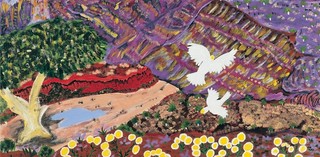Great and Small Kindred Creatures in Indigenous Australian Art

Lindy Rontji, Arrernte people, Australia b.1962 / Mount Hermannsburg 2002 / Synthetic polymer paint on linen / 64.7 x 91.2cm / Purchased 2003 with funds from Margaret Mittelheuser AM through the QAG Foundation / Collection: Queensland Art Gallery | Gallery of Modern Art / © Lindy Rontji / View full image
When
21 Jun 2025 – 3 May 2027
Where
Queensland Art Gallery, Galleries 1 & 2 (Dr Paul Eliadis AM Galleries)
Admission
Free
About
Animals have played a central part in Aboriginal and Torres Strait Islander culture and spiritual beliefs for over 60,000 years. Native fauna form an integral part of relationships with Country, in community and are a foundation of economies, identity and sustainability.
Over many millennia of co-existence animals have been central to survival as a food source, for First Nations people they are also absorbed into lore and culture as images of totemic power; and into the ancestral creation stories that link people, land and animals. ‘Great and small’ is a celebration of these connections.

Craig Koomeeta, Wik-Alkan people, Australia b.1977 / Dingo 2002 / Carved milkwood with synthetic polymer paint / 41.5 x 62.5 x 15cm / Purchased 2002. QAG Foundation Grant / Collection: Queensland Art Gallery | Gallery of Modern Art / © Craig Koomeeta / View full image

Garry Namponan, Wik-Alkan/Wik-Ngatharr people, Australia b.1960 / Sea eagle 2002 / Carved milkwood with natural pigments / 71 x 27 x 33cm / Commissioned 2002 with funds from the QAG Foundation / Collection: Queensland Art Gallery | Gallery of Modern Art / © Garry Namponan / View full image

Attrib. to Jimmy Mulwirrkbirrk Jambalulu, Jalama people, Australia c.1908–1960 / Captured kangaroo / Natural pigments on eucalyptus bark / 48.3 x 30.5cm / Gift of Robert Bleakley through the QAGOMA Foundation 2020. Donated through the Australian Government's Cultural Gifts Program / Collection: Queensland Art Gallery | Gallery of Modern Art / View full image

Angkaliya Curtis, Pitjantjatjara people, Australia b.1928 / Cave Hill 2010 / Synthetic polymer paint on canvas / 170 x 197cm / Purchased 2010 with funds from Margaret Mittelheuser AM and Cathryn Mittelheuser AM through the QAG Foundation / Collection: Queensland Art Gallery | Gallery of Modern Art / © Angkaliya Curtis / View full image

Kunmanara Minyintiri, Pitjantjatjara people, Australia c.1915 - 2014 / Kanyalakutjina (Euro tracks) 2011 / Synthetic polymer paint on linen / 155 x 184cm / Purchased 2011 with funds from Ashby Utting through the QAG Foundation / Collection: Queensland Art Gallery | Gallery of Modern Art / © Kunmanara Minyintiri/Copyright Agency / View full image

Tommy Mitchell, Ngaanyatjarra people, Australia 1943–2013 / Walu Rockhole Dreaming, Emu Heart, The Boy Who Turned Into Wind 2012 / Synthetic polymer paint on canvas / 101.6 x 121.9cm / The Glenn Manser Collection. Gift of Glenn Manser through the QAGOMA Foundation 2014. Donated through the Australian Government's Cultural Gifts Program / Collection: Queensland Art Gallery | Gallery of Modern Art / © Tommy Mitchell/Copyright Agency / View full image

